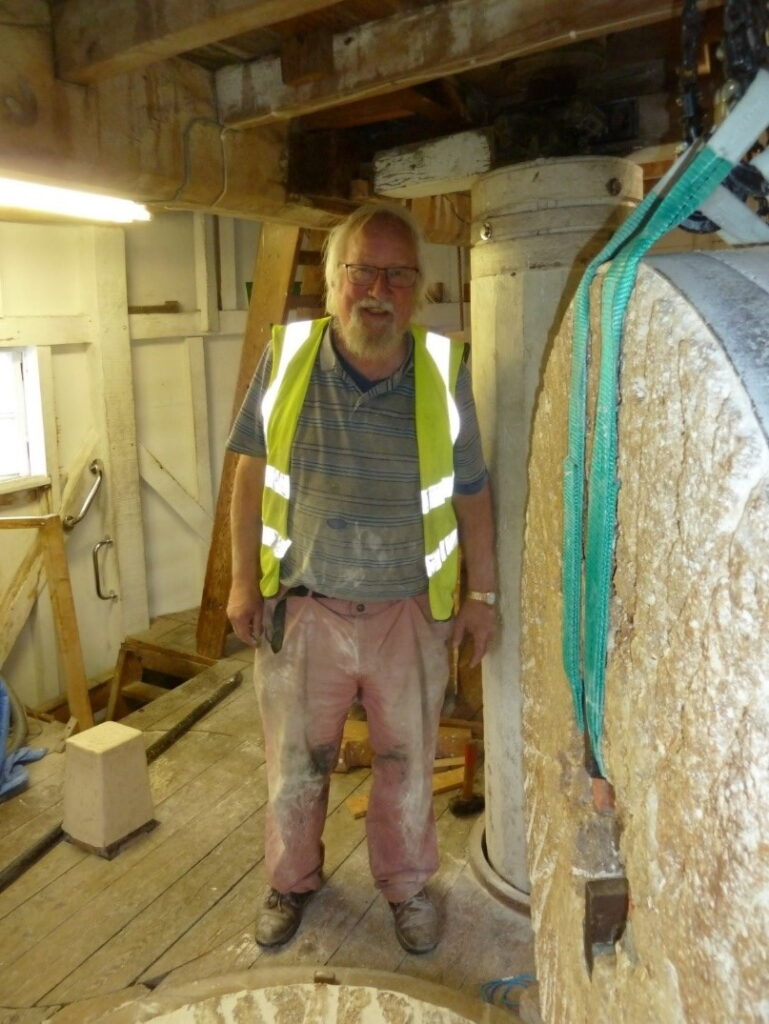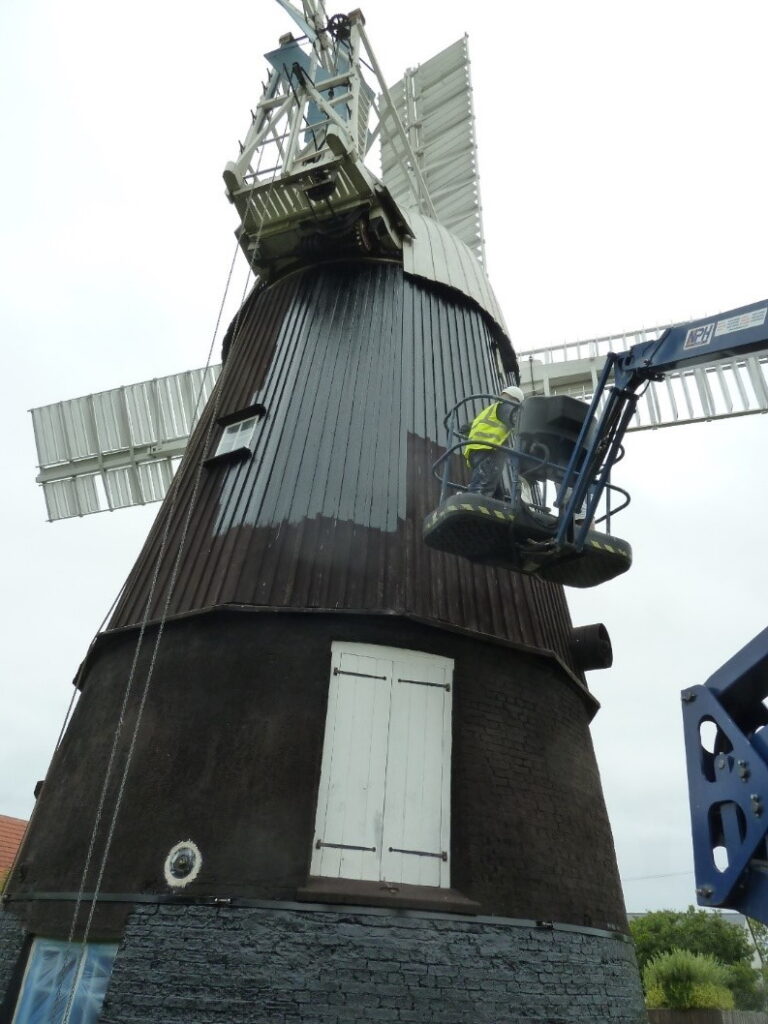By Dave Pearce
Wicken Windmill Partnership
| The mill has been restored by the Wicken Windmill Partnership, acting as millwrights, and its friends and supporters. Once ruinous, the smock windmill is one of very few fully operational. The restoration starting 1987 was only feasible if we did all the work ourselves. The repairs would be professional, but costs kept low. Timescales could be slightly relaxed, allowing time to get things right. The mill has worked since 2001. Every year we set aside a maintenance period. This year work concentrated on the windmill and refurbishing our workshop. We earn income for the mill from flour sales. Recent work carried out by Wicken Millwrights includes: Wicken’s Brake Wheel is mighty, a true bevel gear. Unlike the original it has cast teeth: the timber available was unsuitable for cog mortises. (Wheel design: Dave Pearce, as original but with cast involute teeth. Pattern maker: Chris Hullcoop. Wicken Foundry: Cliff Lovett & Ian Preedy, in aluminium alloy). | |

| The windshaft’s locating squares are set forward, noted by Rex Wailes in the 1920’s. Over time several high tensile screws fatigued. A truss has now been added at the rear of the wheel, resolving the problem we hope. The wooden bevel in the fantail train is thought unique in a working British windmill. It meshes with a modernistic gear. and is on the steering worm’s cast shaft. The wooden bevel is not mentioned in Hunts’ records examined so far (there is a large collection of 19th & 20th century Hunt day books in the Cambridgeshire Archives). An Upwell, Huntingdonshire, legend claims “someone from Wicken took their windmill’s fantail mechanism in the early 1900’s”. Hunt Brothers were millwrighting at Wicken then, so the legend may be true. The wooden bevel is heavily loaded, and we keep regular watch on it. This summer two cogs needed renewal. | |


| Stone Dressing, 2021 The mill has two pairs of 4ft 6in burr stones. The western pair mainly grinds wheat, the eastern rye and spelt. Increasing power demand indicates dressing is due. Once Wicken’s one-legged stone dresser Nick Clay tended the stones – allegedly he could hop up the stairs as quickly as anyone. | |

Two hoists are hung just above bin floor level to gain height when lifting the runner. Our bespoke 2 tonne slings are doubled up for safety.
Policy demands 4 millwrights during a lift: 2 on the hoists, and 2 manoeuvring the stones: one should be in charge and watching over safety. Sometimes we have a 5th millwright, tasked with keeping watch on proceedings.
Dave, Dan Carrick, Robert Bramley, and Pip Smith have just raised the runner, with Graham Hackney observing for extra safety.
Going to plan … Dave Pearce
| The bedstone is coated red to show high spots. Children’s poster paint suffices instead of red ochre. The prevalence of red shows the outer part of the stone is reasonably flat, needing limited attention. The lack of red closer to the centre shows the stone is dished, to draw grain between the stones. Reinforcing Hoop There are two old cracks in the brick base, one over the main door, and another about a quarter round. They are not developing but the hoop has been fitted for reassurance. The steel band was made to our specification by Mr M. Overall, the Cottenham blacksmith. It is coned to suit the tower. It sits between the main door arch and the meal floor door sills. | |


close

Pip Smith mortaring the crack above the mill door
The crack is widest on the inside
| The Foundry Wicken Windmill is fortunate in having this. It helps retain disappearing skills, saves money, and casting is a remarkable process! The foundry had been cold for some years, but a request from Gransden Mill for shutter cranks, thimbles and cleats encouraged reactivation. There is a possibility of fitting thimbles to a Wicken sail bay. | |

Old iron thimbles found at Wicken and Gransden appear identical, and Hunts purchased sail fittings from Wilkinson’s Ely foundry in 1873 for Sechell’s Mill, Haddenham. We also need to cast a bevel pinion for the Wicken auxiliary machines drive.
Rob Bramley is working the foundry, the charge of alloy approaching melt. The moulding boxes in the foreground are for sail shutter fittings

| The Wicken Windmill workshop is central to sustaining the working windmill. Millwrights need proper facilities to achieve their goals. Our workshop is in the old granary, with a range of second hand machinery which continues to do heroic work. It was originally a pitched roofed building, across the yard from the mill, & converted in the 1950’s with simple sloping roofs. We knew from 1987 that the workshop needed reroofing. A start was made years ago, last year the foundry was reroofed with corrugated steel sheet after contractors removed asbestos cement roofing. | |

A replacement roof, July 2021
The millwrights fitted new wall plates, rafters and purlins, & corrugated steel roof sheets. We need a fully functioning workshop to maintain the windmill!
Graham Hackney, Robert Bramley, & Elwyn Davies just out of view
Work away 1. Gransden Mill brake, 2021. This ancient Huntingdonshire mill is currently owned by Cambridgeshire County Council. | |

Millwright Bill Griffiths, and before that Richard Seago, carried out extensive structural repairs for the County, supported by Historic England. Cambridgeshire Windmills Consultancy (Dave Pearce & Martin Davies) provided technical advice, and is organising volunteers to continue mechanical repairs. Not surprisingly Wicken Millwrights are involved.
The ‘original’ brake lever has been reinstated. It is shown with the preserved brake hook and brake pulley, and a temporary brake rope
| 2. The mill at Foxton, Cambridgeshire is unique in the UK, supplying drinking water from an artesian well. In the 1870’s the vicar, Canon Selwyn, improved the villagers’ water supply, previously taken from shallow wells. | |

Pressure in the aquifer raised water within reach of suction pumps. Two deep wells with hand pumps were sunk. The 6-sailed windmill was built to pump water from a third well to tanks in the roof of the Canon’s house.
The mill fell on hard times – the sails were blown off in 1992.
The sails are interesting. Six have been rebuilt, several being almost entirely new. Four remain to be fitted. The general appearance is of a fantail, 16ft diameter. Uniquely now, each blade has radial shutters, spring controlled. The millwright could be Rawlings.
Graham Hackney got permission from owner Mr Welch for Wicken Millwrights to make repairs. These have proved extensive

Tarring, Wicken, August 2021
These days we hire a hydraulic lifting platform annually, for safety inspections and checking the tightness of sail fixings. We inspect the paintwork on sails and cap: the sails take a ‘rare pasting’ from the fen blows and on average need repainting every four years. The cap roof over the storm hatch also needs frequent attention.
The smock too is retarred four-yearly. The south-easterly faces deteriorate fastest: maybe harsh sunlight causes damage more than wind and rain.
The cost of paint and equipment hire are two of Wicken Mill’s major expenditures, eased by our millwrights and millers working so effectively. We have sustained the mill in full going order for 20 years, but must look to even harder effort to build up funds for the future.
Dan Carrick (& David Wall out of sight) tarring the smock
| Ready for work, September 2021 | |
| Father, Mother, Sister, Brother, We run all day, Can’t catch each other, Who are we? Old Wicken rhyme, remembered by Miss Monica Barton. |

